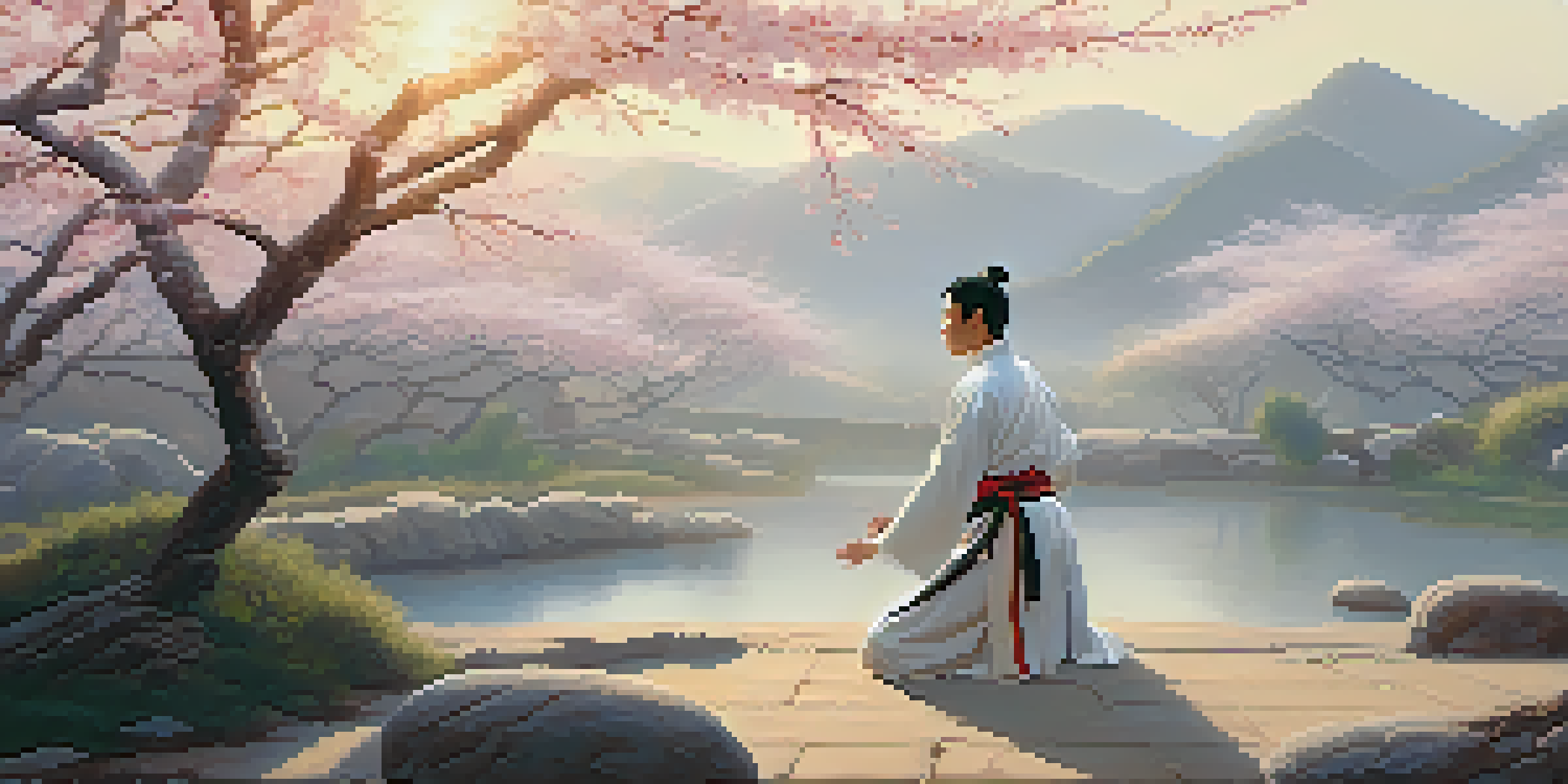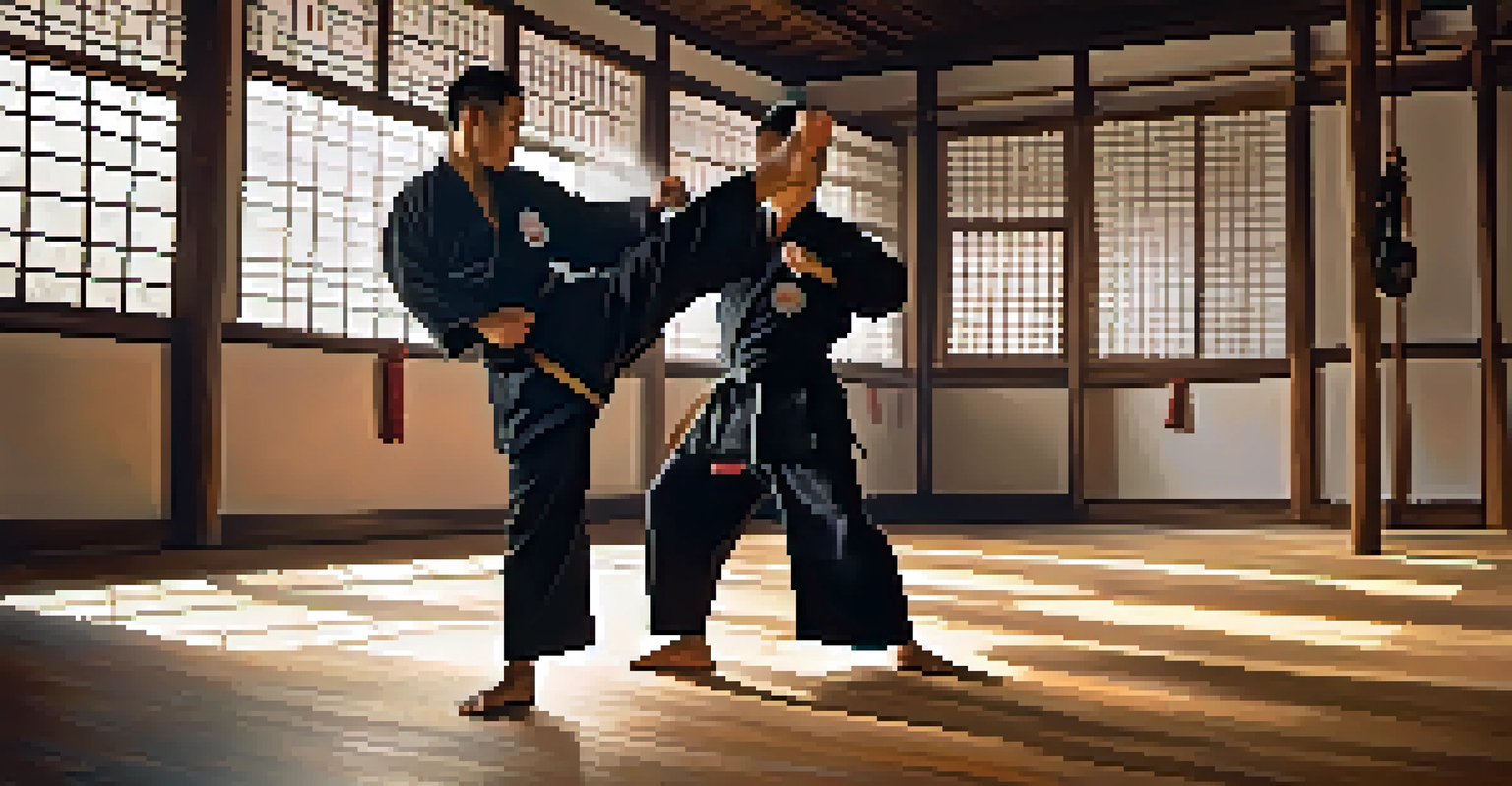Martial Arts and Their Role in Ancient Asian Warfare Tactics

Understanding Martial Arts in Historical Context
Martial arts have roots deeply embedded in the histories of various Asian cultures. They were often not just forms of self-defense but were integral to the military training of warriors. From the disciplined movements of Kung Fu to the strategic grappling of Jiu-Jitsu, these practices were designed to enhance combat effectiveness.
Martial arts are ultimately about the development of character and the cultivation of the mind, body, and spirit.
In ancient times, martial arts were often taught in temples and schools, where students learned not just techniques but also philosophies of discipline and respect. This holistic approach meant that warriors were not only trained in physical skills but also in mental fortitude and ethical conduct.
The evolution of these techniques over centuries reflects the changing nature of warfare itself. As battlefields grew more complex, so too did the martial arts, adapting to new weapons, strategies, and the demands of different combat situations.
The Role of Strategy in Martial Arts
Strategic thinking is at the heart of many martial arts disciplines. Each technique is not merely a physical action but a calculated move intended to outsmart an opponent. This emphasis on strategy mirrors the broader military tactics employed by ancient Asian armies.

For instance, in Chinese martial arts, the concept of 'Yin and Yang' illustrates the balance of opposing forces, which is crucial in both combat and warfare. Understanding your opponent’s strength and weaknesses allows a martial artist to exploit gaps in their defense, much like a general would on the battlefield.
Martial Arts Rooted in History
Martial arts have historical significance, serving not only as self-defense techniques but also as vital components of military training across various Asian cultures.
Thus, martial arts training often involved simulations of real combat scenarios, honing the practitioner's ability to think critically under pressure. This integration of strategy and skill made martial arts an essential component of military preparation.
Key Martial Arts Influencing Ancient Warfare
Several martial arts have particularly influenced ancient warfare tactics across Asia. For example, the Japanese art of Kenjutsu, focused on swordsmanship, was crucial for samurai warriors. Mastery of the katana was not just about skill; it embodied the samurai's entire ethos.
The ultimate aim of martial arts is not having to use them.
Similarly, Taekwondo in Korea evolved from ancient military training methods, emphasizing powerful kicks that were both offensive and defensive. This martial art was designed to keep warriors agile and adaptable on the battlefield, which proved invaluable during conflicts.
In India, Kalaripayattu is one of the oldest fighting systems and incorporates elements of yoga and Ayurveda. This blend of physical prowess and mental discipline helped warriors maintain peak physical condition while also fostering a deeper understanding of their bodies.
The Philosophy Behind Martial Arts and Warfare
The philosophies underpinning martial arts have long influenced warfare tactics. Many disciplines promote principles such as respect, humility, and self-control. These values not only shaped individual practitioners but also had wider implications for the conduct of war.
For instance, the samurai code of 'Bushido' stressed honor and loyalty, which governed how battles were fought. This ethical framework helped maintain order and discipline among troops, creating a cohesive fighting force.
Strategy is Key in Combat
Strategic thinking is central to martial arts, with techniques designed to outsmart opponents, reflecting broader military tactics.
Moreover, the spiritual aspects of martial arts often encouraged a warrior to seek peace rather than conflict. This mindset was crucial in preventing unnecessary bloodshed and fostering diplomacy, even amidst warfare.
Training Regimens and Their Military Applications
Martial arts training regimens were meticulously designed to prepare soldiers for the rigors of battle. These included not only physical conditioning but also mental training to improve focus and resilience. The repetitive practice of techniques helped build muscle memory, essential for split-second decisions in combat.
For example, in Shaolin Kung Fu, practitioners engage in rigorous drills that enhance flexibility, strength, and reflexes. This training developed warriors who could respond instinctively to threats, a critical advantage in chaotic battle scenarios.
Additionally, many martial arts incorporated weapons training, teaching soldiers how to effectively use various tools of war, from swords to staffs. This comprehensive approach ensured that warriors were well-prepared for any situation they might encounter on the battlefield.
Martial Arts as a Reflection of Cultural Values
Martial arts often reflect the cultural values and historical contexts of the societies from which they originate. In many Asian countries, martial arts are esteemed not just as combat techniques but as a way of life. This cultural reverence has helped preserve these practices over centuries.
For instance, the emphasis on discipline and respect in Korean martial arts parallels the Confucian values central to Korean society. Such cultural ties ensure that martial arts training is not only about physical prowess but also about moral development.
Cultural Values Shape Practices
Martial arts embody the cultural values of their origins, emphasizing discipline and respect while contributing to moral development.
This connection between martial arts and cultural values has contributed to their enduring legacy in modern times, as they continue to inform contemporary practices and philosophies in various fields, including military strategy.
The Enduring Legacy of Martial Arts in Modern Warfare
The influence of ancient martial arts on modern warfare tactics remains significant. Many military organizations around the world incorporate martial arts training into their programs, recognizing its benefits for physical fitness and mental discipline. Techniques derived from these ancient practices can enhance hand-to-hand combat skills and improve overall effectiveness in various military scenarios.
In addition, the philosophy of martial arts continues to inspire modern military leaders. Concepts such as adaptability, strategic thinking, and resilience are crucial in today's fast-paced and unpredictable environments.

As we look at contemporary conflicts, it's clear that the lessons learned from ancient martial arts are still relevant. The blend of physical skill and mental acuity that martial arts instill in practitioners serves as a valuable asset in the ever-evolving landscape of warfare.